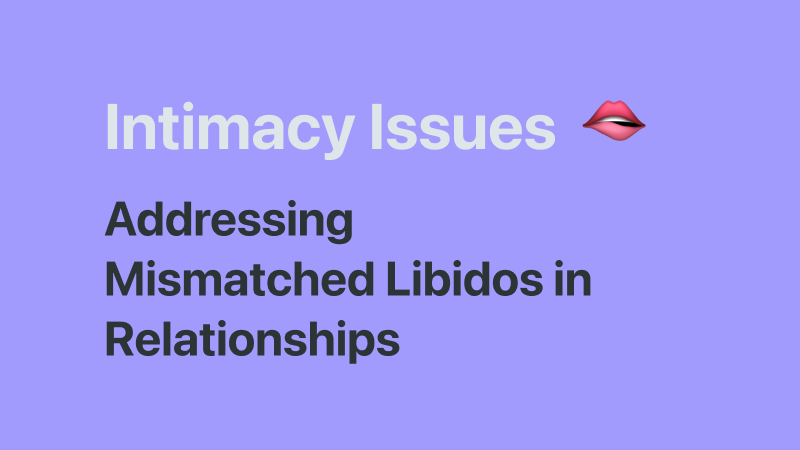Understanding Mismatched Libidos
It’s not uncommon for couples to experience mismatched libidos at some point in their relationship. Libido, or sexual desire, can fluctuate based on numerous factors such as stress, health, age, or simply personal preferences. What happens when one partner wants sex more frequently than the other? It can lead to frustration, confusion, and even feelings of rejection if not properly addressed.
Having a different sex drive doesn’t mean your relationship is doomed or that you’re incompatible. In fact, it’s a challenge that many couples successfully navigate with the right communication and understanding.
Causes of Mismatched Libidos
Before diving into solutions, it’s important to recognize that a difference in sex drive isn’t necessarily anyone’s fault. Here are some common reasons couples experience mismatched libidos:
• Stress and Fatigue: Work pressure, family responsibilities, and lack of sleep can all affect sexual desire.
• Health Issues: Hormonal imbalances, medication, or chronic health conditions can reduce libido.
• Emotional Disconnect: When partners feel emotionally distant, it’s harder to feel a physical connection.
• Life Changes: Major life transitions like having kids, moving, or starting a new job can shift priorities and impact libido.
• Mental Health: Anxiety, depression, or other mental health concerns can lower sexual desire.
Reconnecting Physically and Emotionally
Having different levels of sexual desire is completely normal, but what’s crucial is how couples manage the difference. Here are strategies to help you and your partner navigate mismatched libidos and build a closer, more intimate connection.
1. Open and Honest Communication
The first step in addressing mismatched libidos is to talk about it. It might feel awkward at first, but discussing your feelings, needs, and frustrations can prevent bigger issues from building up. Let your partner know how you’re feeling without placing blame. Start the conversation gently, focusing on how to improve the relationship rather than making it about who’s at fault.
2. Explore Non-Sexual Intimacy
Sometimes, emotional intimacy is just as important as physical intimacy. Try spending more time connecting in non-sexual ways—cuddling, holding hands, kissing, or even just sitting together and talking. These small gestures can help build emotional closeness, which often reignites the physical spark.
3. Find a Middle Ground
Relationships are about compromise. If one partner has a higher libido and the other has a lower one, finding a middle ground is key. You don’t need to force sex, but finding ways to be intimate that meet both partners’ needs can bridge the gap. This might include scheduling time for intimacy or exploring activities that are enjoyable for both.
4. Reduce External Stressors
As mentioned, stress is a big libido killer. Addressing external factors like work, family pressure, or even fatigue can help. Make sure both partners are getting enough rest and creating space in your lives for relaxation and fun together.
5. See a Professional Together
If mismatched libidos are causing significant strain on your relationship, it might be helpful to see a therapist or sex therapist. A professional can help you both navigate the conversation and offer strategies that are tailored to your specific relationship dynamic.
What Not to Do When Addressing Mismatched Libidos
While it’s important to find solutions, there are some things that can make matters worse. Here’s what to avoid:
- Don’t Pressure Your Partner: Pressuring your partner to engage in intimacy they’re not ready for can harm your relationship. Consent and comfort should always come first.
- Don’t Blame Each Other: It’s easy to feel frustrated, but avoid blaming your partner for the difference in libido. Remember, desire levels can change over time due to many factors.
- Don’t Ignore the Issue: Sweeping mismatched libidos under the rug can cause resentment.
- Address the issue calmly and directly rather than letting it fester.
Exploring New Avenues for Intimacy
If your sex life feels a bit stagnant, trying new things together can sometimes reinvigorate your connection. This could mean exploring different forms of intimacy or even new experiences in the bedroom that you’re both comfortable with. Keeping an open mind and staying curious can help both partners feel more satisfied.
Another key to maintaining a healthy sexual connection is recognizing that it’s okay for libido to fluctuate over time. Life events, aging, and changing dynamics in your relationship will all play a part, but understanding, patience, and connection are what keep the bond strong.
Self-Reflection Question:
How do I approach conversations about intimacy with my partner, and how can I foster better communication around our physical and emotional needs?
Quick Quiz:
1. What is a key factor that often impacts libido?
a) Stress and fatigue
b) Personal preference
c) Career success
2. What should you avoid doing when addressing mismatched libidos?
a) Pressuring your partner
b) Ignoring the issue
c) Both a and b
3. What is one way to reconnect emotionally without sex?
a) Holding hands and spending time together
b) Ignoring the problem
c) Having the same libido as your partner




